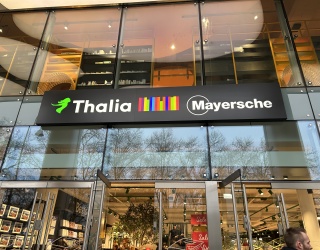
With new construction in the food trade, too many savings opportunities are still being passed up, believes Jan Kröger, who is the Managing Director of Hafner-Muschler since January 2010. Prior to that, he worked 15 years for competitor Epta, last among other things he was in charge of business in Germany. HM is a specialist in cooling technology, hydraulic systems, combined cooling and heating technology and geothermics. The company from Balingen, Germany, showcased a pilot project with Aldi Süd at the EuroShop. Will more come out of this? Does ground storage energy pay off? How can regenerative energies be used sensibly?
In the fall you and Aldi Süd realized a pilot project on energy savings. What was done there?
This was an Aldi store in Rastatt, which was newly rebuilt on the site of on old branch. The sales area is quite large and spans about 1100m2. The store concept at Aldi Süd (Aldi South) today is already on a high technological level. It’s our goal to again cut down 47 percent in energy from the established standard. This project is a true pilot project: it is primarily about analyzing metrics and to evaluate corresponding data. We want to gain knowledge on how system blocks can be optimally aligned with each other – and of course to also prove, which potential savings are actually possible with an intelligent concept. This project was developed in collaboration with the Fraunhofer Institute for Solar Energy Systems. The scientists in Freiburg, Germany, analyze the store’s long-term energy consumption in detail.
In retail there are several green pilot projects, which then remain a one-time occurrence. Do you see the possibility with Aldi to really have many stores being rebuilt or newly built based on this model?
In this project’s building services engineering we exclusively incorporated scalable solutions. This was always an important focal point. We want to prove the system’s success. Success actually also means, that an additional investment can also be economically demonstrated. I am convinced, that individual system building blocks from this project can be mass produced.
What equipment and control technology are required to use the waste heat from cooling for heating?
In a traditionally built house, only a fraction of the waste heat from the cooling system can be used for heating. At first a building needs to be adapted with respective insulation, effective and controllable air conditioning and – most importantly – with radiant panel heating. Such a designed building then can be sufficiently heated with a heater flow temperature of about 30°C even in the winter. With such a low heater flow temperature, the waste heat from the cooling system can truly be utilized 100 percent. And there is the rub: This way, 80 to 85 percent of a supermarket’s heat inside the building can be covered by the cooling system. The remainder is supplied by a heat pump or a gas burner. You need a central control system for such a cross system engineering process. At the moment we program our software on our own and thus create the ideal degree of freedom to be able to control everything just like we need it.
With the Aldi project, you store the surplus thermal energy that’s generated during the summer in the ground under the parking lot. How high will the heat loss be? Would an insulated water tank not be more efficient?
We guide heat that we virtually get for free during the summer months into the ground. When the winter season starts, the soil is warmer, which significantly improves the efficiency of the heat pump. If the heat is now being pulled out, the temperature in the surrounding area of the sensor drops to a normal level and shortly after drops just below normal level. But then more heat streams in the sensor’s direction and provides the heat pump with heat.
In an insulated water tank you only have the actively poured in heat in the tank. If this heat is used up, nothing else follows. Imagine there is a long, hard winter coming. If at one point the water in the tank is just before the freezing point, you won’t have a buffer anymore. Compared to the ground, there won’t be regeneration.
We use water tanks as an additional temperature buffer, if they are already available in the building anyway. Depending on the tank size, you can use such fire water storage tanks in a logistics structure approximately two to four weeks to cover the entire heating demand with a heat pump.
What is the benefit of concrete core temperature control? Is floor heating also feasible in already existing stores?
Concrete core tempering is recommended for new buildings. The great thing about it is the low flow temperature of the heating system. Only in this way can the waste heat of the cooling system be effectively utilized. We have other options for existing stores with panel heating, to achieve a comparable effect. For reconstruction for example, we work with ceiling lighting systems by our sister company Zent-Frenger, which also very effectively utilize the heat.
Which options make sense to use regenerative energy sources cost-effectively?
I can find an ideal solution for every customer, but not every solution is equally well suited for each customer. You always have to consider the building and the site. We have sorted all components of our system technology in a matrix. For instance, can geothermal energy or ground water be used at a site? We have every technical option to use even unconventional items like fire water storage tanks or base activations. During the conception stage we award points for the selected technical details, and can then tell our customers in what HM-energy efficiency category the overall solution falls. The objective is to offer the optimal combination of components at every site.
Groundwater use requires an official authorization. What is the legal situation?
We file an application for the use of ground water with a preliminary approval through the department of water management. This is actually a very unbureaucratic process. The water volumes and temperatures are specified there. Groundwater is often available. The efficient use depends on the water quality and the depth of the well. Since the water still needs to be transported to the top. The deeper the well is, the more energy you need. The authorities usually make sure that in the ongoing process the same amount of water is discharged as is taken and the temperatures are within ecologically agreeable limits. These are fundamentals for sustainable groundwater management.
How big do you think the savings potential in German food retailing is, if all cooling systems were immediately brought up to date?
That’s a very difficult question to answer. But I am playing it by ear here and say: overall for all facilities of food retailing that’s about 25 percent. However, it gets more interesting if you ask this: How much gas or oil could you save in the entire building? There I would estimate the potential savings to be 35 to 40 percent.
What kind of retrofitting pays off for existing properties?
The cooling system is always being looked at. Generally, window strips are also being replaced. If the ceiling has already been cleared up, you can also install radiant panel heating. With a new cooling system, waste heat recovery and low temperature heating the facility is complete. The burner then just has to deliver very little post heat – the building is overall considerably more effective than before.
What can a butcher shop with a cold storage room and refrigerated display case do in terms of energy optimization? Or a pastry shop?
Ultimately the same thing a supermarket can do. The cooling system is smaller, but so is the area of heat demand. A butcher or pastry chef needs a lot of warm water – that’s why a cooling agent should be used that creates high pressure gas temperatures. This way the warm water can be effectively produced.
Are there government-subsidized support programs for smaller retailers?
The support programs are tied to size. That’s a problem. As far as I know, politicians have an eye on this and are working on support programs for smaller consumption figures. If I know this correctly, assistance is available on the state level and through the KfW banking group there are also grants available that are beneficial.
Who are your most important customers and where are the booming sales markets?
We work with all types of commercial enterprises. I believe Germany leads the way in terms of total energy concepts. It’s a pity that there still is a lot of conventional construction for new buildings going on. Too many savings opportunities are still being passed up here. Over the past few weeks, many customers from abroad have approached me who would like to use our technology – particularly from Austria and Eastern Europe.
What trade fair conclusions do you draw after the EuroShop 2011?
The trade show was a big success for us. The highlight for us was of course the contract conclusion with Aldi Süd (Aldi South). After all, you don’t negotiate contracts at this trade show, but we got two new verbally agreed upon orders. We were obviously delighted about that.
René Schellbach, First Publication: EuroShop.de
01/12/2011





